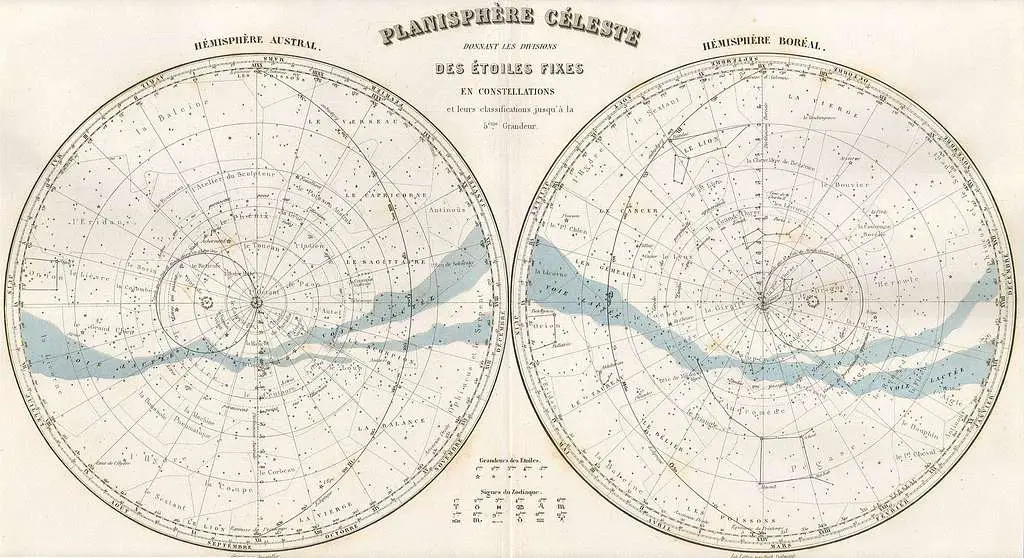If you’re looking to fill up your star chart this winter, you’ll have the opportunity to view some very different constellations in the northern and southern hemispheres. The celestial hemisphere you’re in depends on your geographical location on earth. Find out which constellations will be visible on both sides of the equator with this guide to the northern and southern hemisphere constellations, or read on to learn about each hemisphere separately.
Ursa Major (Great Bear)
The Great Bear is not actually a bear at all. It’s a constellation in northern hemisphere that appears to be shaped like a dipper (hence its other name, The Plough). The brightest star in Ursa Major is known as Polaris, or The North Star. It points due north, making it an essential navigational tool for stargazers.
Cygnus (Northern Cross)
Just to the right of Deneb, one of Cygnus’ brightest stars, is an easy-to-spot asterism known as the Northern Cross. Once you see it, you won’t forget it. But because it contains only dim stars (and no first magnitude stars), not many people see it! Use binoculars or a telescope to help pick out some of its fainter members. The Northern Cross is best seen in June from mid-northern latitudes; from southern latitudes, it never rises very high above the horizon. From mid-northern latitudes, look for it just after sunset in early June or after midnight in late July and August.
Aquila (Eagle)
Aquila is one of most visible constellations. To view Aquila, look for a W or a V shaped asterism (or star pattern) formed by its brightest stars. The constellation is recognized from Earth’s northern hemisphere during summer, but can be seen during spring in southern hemisphere. In ancient times, Aquila was associated with Zeus’ eagle that carried thunderbolts. In modern times, it is often used as an orientation point to locate other nearby constellations.
Lacerta (Lizard)
It’s no surprise that Lacerta—the Lizard—is visible in both northern and southern hemispheres. The constellation’s shape was chosen to represent a lizard (as one might suspect), but its stars are faint, so it may not be easy to spot for casual stargazers. Regardless, you can find Lacerta by starting with its brightest star: Alpha Lacertae.
Delphinus (Dolphin)
The Dolphin is a small constellation, bordered by Equuleus, Aquila, Hercules, Boötes and Pegasus. Visible in both hemispheres during autumn, winter and spring. One of its brightest stars is Sualocin (Alpha Delphini), with a magnitude of 3.4. The Dolphin was first catalogued by Greek astronomer Ptolemy in his treatise Almagest circa 130 AD/CE.
Sagitta (Arrow)
Sagitta is among the faintest constellations in either hemisphere. It was originally part of Vulpecula, but it was later separated out into its own constellation in 1752 by Lacaille. Sagitta is a faint constellation that takes up only 156 square degrees, making it one of smallest constellations. It also contains no bright stars; its brightest stars are ranked as magnitude 5 or 6.
Pegasus (Winged Horse)
One of the most prominent constellations in both hemispheres, Pegasus is large, easy to spot and contains only a few stars. It’s more or less in line with two other prominent summer sky features: Vega (Alpha Lyrae) in Lyra constellation and Aldebaran (Alpha Tauri) in Taurus. Other notable stars include Enif (Beta Pegasi), Deneb Kaitos (Delta Pegasi) and Scheat (Epsilon Pegasi).
Andromeda Galaxy, M31, NGC 224, And IC 1179
The Andromeda Galaxy is a spiral galaxy located in the constellation Andromeda. It is also known as Messier 31, or M31. The Andromeda Galaxy can be seen without a telescope by those with excellent eyesight on clear, dark nights. It is an irregularly-shaped galaxy 2.5 million light years from Earth, making it our closest galactic neighbor. In fact, due to its large distance from Earth, it takes light from M31 two million years to reach us!
![]()
